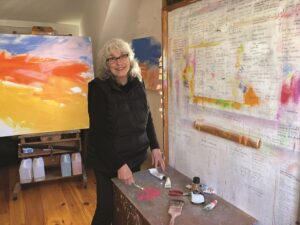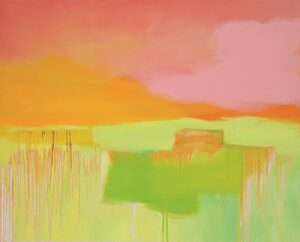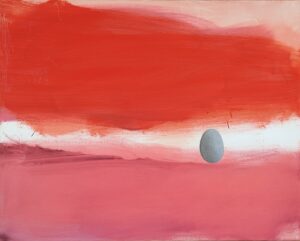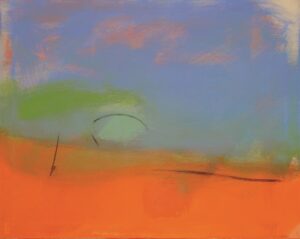Sky Power points to a loosely defined shape in her painting Interior of a Landscape. It could be a boat floating in water: an orange rectangle rising from a half-moon shape looks like the wheelhouse of a fishing boat. But she also sees it as a reference to a caprock near her childhood home in Post, Texas.

“I lived below it,” says Power, describing the stony escarpment dividing the high plains from the surrounding terrain. “This painting is about the two environments that affected me the most — where I was raised in West Texas, and Provincetown, which has been my home since 1976.”
Power’s images tend toward abstraction instead of literal depictions of places. Her colors are expressive and bright, more internally directed than externally sourced. She loves the combination of colors in the pink and orange sky and the drippy electric green in the painting. The green is an ambiguous space that could represent water or perhaps an expanse of plains.
“Here in Provincetown, if you look out on the water, there’s the horizon. It’s infinite,” says Power. “And the same thing in West Texas. It was perfectly flat. That’s a place to dream — on the horizon.” This sense of expansion runs through all her work, rendered with brash swaths of pure color.
The openness in Power’s paintings and their beckoning horizons reflect motifs in the artist’s life. “I always identified as an artist because I was doing it from seven years old,” says Power. “I was painting with my mom and her peers. That made a difference in my identity. I didn’t have that bridge to cross to be an artist.” Her family moved to Wyoming, where Power finished high school. She eventually enrolled at the Cornish School of Allied Arts in Seattle. “I didn’t maintain friends in Wyoming because they were all afraid of me,” she says. “I came out, and I changed my name in Seattle. I didn’t know what I wanted to change it to, but then the name Sky came to me, and I thought, ‘Oh, I love that name.’ ” (She says her family laughed at it at first, “but over the years they got used to it and had to call me Sky.”)

Powers moved to the East Coast and eventually settled in Provincetown after visiting to help a friend start a horse-and-carriage business. “I was so thrilled by the time I found Provincetown, where we don’t think about who’s straight or who’s gay,” says Power. “We just live our lives and respect one another for the most part. That was very comforting. I think that’s why I’ve stayed here — besides it being such a gorgeous environment.”
Fittingly, skies figure prominently in Power’s paintings. One of the most arresting ones is the yellow expanse in Clear Water. Transparent strokes of gray paint run across the yellow to evoke quickly moving clouds.
Power begins her paintings with a wide brush loaded with paint. “I start off with free abandon,” she says. She alternates laying down paint and wiping it away in order to find forms with color. “As abstract artists, we’re creating our own forms and structures,” she says. “We do that with color, line, and the absence of both.” After working intuitively, she studies her paintings “like a chess game,” putting them aside for a time. She works on up to a dozen paintings at once.
During this process, Power has an uncanny ability to keep the paintings feeling fresh and improvisational until they are finished. Wiping away and layering paint lays bare the act of creation. This is clear in Duet, a small painting of an orange ground and blue sky with vague forms sandwiched between the two fields of color. The forms in the middle of the painting — quick charcoal lines and amorphous green shapes —articulate a loose composition but never fully crystalize as concrete objects. Instead, they become forms simultaneously defined and subsumed by color and gesture. The energy of the artist and the elemental power of color dominate. As a result, Power’s paintings communicate an experience of the sublime — like witnessing a sunset — where color and spirit overwhelm and blur the line between one’s self and the surrounding elements.
In other paintings, Power refines her forms more explicitly by inserting realistic imagery into otherwise abstract compositions. A Dream in a Dream contains a meticulously rendered image of an egg in a strip of white that separates two larger swaths of red paint.

“It took a few sessions to find the two red forms,” says Power. “But it wasn’t a strong enough composition. I had it for months before I could figure out how to resolve it. One day I pulled the painting out and put an egg in there. The egg is tying these two forms together, and it creates a balance and an intrigue.” Similarly, The Gift juxtaposes a red bowl, dripping and bloody, with another orange bowl resting on a thin black line: a painting where Power processed the experience of injuring her hand and her eventual recovery. “This is the balance I found,” she says, referring to both herself and the image she created.
Unlike some abstract artists, Power isn’t afraid to incorporate realism into her paintings or talk about her abstractions as referencing real-life experiences. A sense of freedom has always been important for her. For years, she worked in restaurants and as a carpenter, piano tuner, and director at Berta Walker Gallery in order to be free from the demands and compromises that can result from the decision to make a living as an artist. As a painter, she continues to move freely between different ways of creating and pulls from all parts of her life to make art.
“My art reflects my life experience, my environment, and my internal world,” says Power. “My internal world is limitless in an abstract form.”

Beckoning Color
The event: An exhibition of work by Sky Power
The time: Through June 25
The place: Provincetown Art Association and Museum (460 Commercial St.)
The cost: $15 general admission; see paam.org for information



